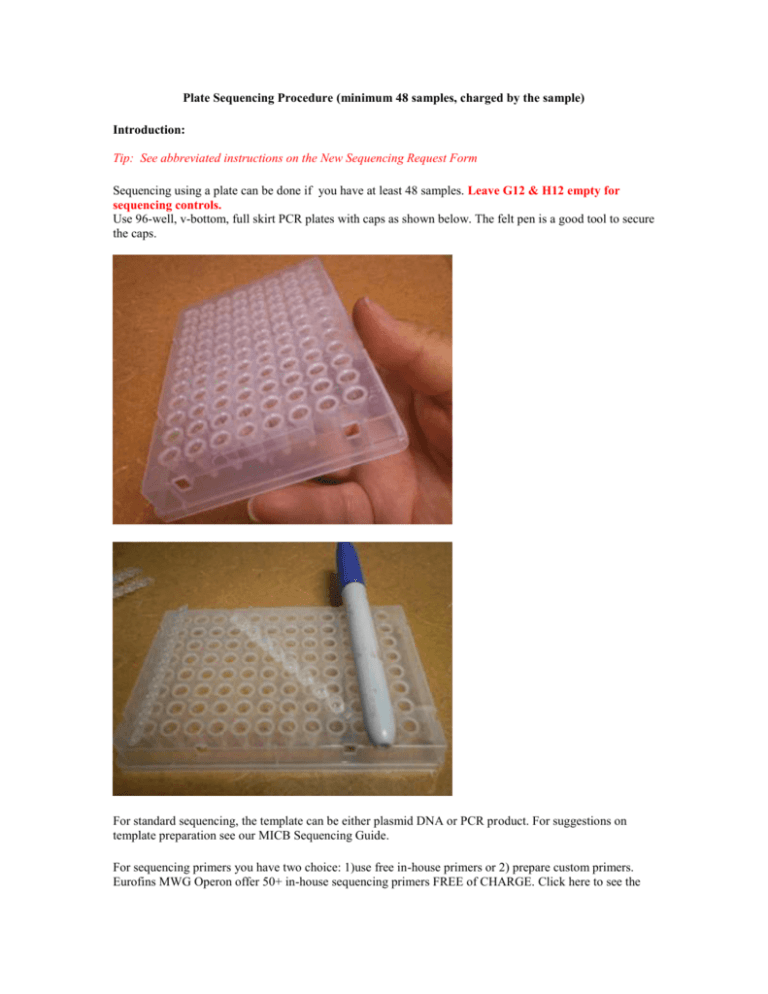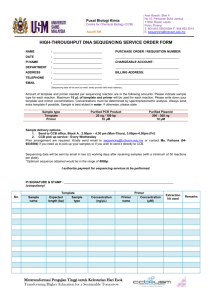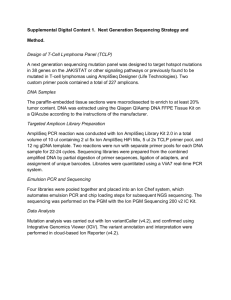Plate Sequencing Procedure (minimum 48 samples, charged by the
advertisement

Plate Sequencing Procedure (minimum 48 samples, charged by the sample) Introduction: Tip: See abbreviated instructions on the New Sequencing Request Form Sequencing using a plate can be done if you have at least 48 samples. Leave G12 & H12 empty for sequencing controls. Use 96-well, v-bottom, full skirt PCR plates with caps as shown below. The felt pen is a good tool to secure the caps. For standard sequencing, the template can be either plasmid DNA or PCR product. For suggestions on template preparation see our MICB Sequencing Guide. For sequencing primers you have two choice: 1)use free in-house primers or 2) prepare custom primers. Eurofins MWG Operon offer 50+ in-house sequencing primers FREE of CHARGE. Click here to see the full list. If you need to prepare your own sequencing primer then YOU WILL NEED TO CONFIRM that your primer is suitable ie that it does not form primer-dimer pairs, that it does not self compliment, that it’s Tm is not too low etc. This is best done using a primer analysis program. For more info see http://primerdigital.com/fastpcr.html and try their FastPCR Online tool. In general these are the preferred characteristics of your primer: 1) 18-30 nt in length 2) 40-60% GC content 3) Tm between 50oC-70oC 4) No primer-dimer pair formation particularly at the 3’ end of the primer 5) Confirm that the primer is unique within your sequence Remember that even though your primer meets all the above criteria THERE ARE NO GUARANTEES it will work. The ultimate test is the sequencing. If your sequencing primer is NOT ideal then you can try to increase the primer concentration in the sequencing reaction from 2uM to 10uM. Sequencing Plasmid Based Templates: Tip: Need more information see MICB Sequencing Guide Amount of template used depends on the size of the template; larger the size the more template is needed. For plasmids template use the following as a guideline: plasmid size 2-3Kb use 150 ng/ul plasmid size 3-5Kb use 200 ng/ul plasmid size 5-8Kb use 300 ng/ul plasmid size > 8Kb use 400 ng/ul Pay attention to your pipetter. Monitor the pipetting to confirm that the amounts look correct. Sequencing data will start 20+ nucleotides from the 3’ end of the primer site. 1. 2. 3. 4. 5. 6. 7. To a well on the plate, add 8ul of the appropriate concentration plasmid template. If you are adding a CUSTOM primer, add 4ul of CUSTOM primer at 2uM (pmol/ul). Your total volume in each well will now be 12ul. Load samples down each column A1, B1, C1, D1....... A2, B2, C2, D2....... etc Total volume per well should be 10ul template alone or 12ul template & CUSTOM primer [8ul template + 4ul CUSTOM primer]. This is enough sample for TWO sequencing reactions. If you are short on template the minimal amount is 5ul template or 6ul template & CUSTOM primer. Leave G12 & H12 empty for sequencing controls Once all samples are loaded, cap the wells using a dimpled felt pen bottom as shown in the photo below. TIP: Do the first and last caps or each strip initially to ensure remaining caps align properly. 8. 9. Complete the Eurofins MWG Operon Plate Sequencing Order Spreadsheet. Email the completed sheet to me at ddubik@cc.umanitoba.ca The labelled plate and a completed New Sequencing Request Form should be brought to the Sequencing Room ON6042 in Cell Biology (6th floor of the CancerCare Manitoba Bldg., 675 McDermot Ave.). Place the request form in the holder at the door and the plate the minifreezer. NOTE: If you have provided me with a completed Eurofins MWG Operon Plate Sequencing Order Spreadsheet, there is no need to reproduce the sample information on the New Sequencing Request Form. On the Request Form simple state: a) The plate name; b) Total number of samples provided. Sequencing PCR Based Templates: Tip: Need more information see MICB Sequencing Guide PCR Product Analysis Sequencing from PCR products is usually more problematic than sequencing from a plasmid. Not all PCR products are appropriate for sequencing For information on QC of PCR products and methods of cleanup see our MICB Sequencing Guide. Sequencing Primer Selection Q– Can I sequence using the same primers used to generate the PCR product? A– Ideally you would want to use a nested primer distinct from the PCR primer; however, in many cases using the same primer will give good sequence. The primer (particularly it’s 3’ end) must be able to bind the PCR product DNA strongly to initial elongation. If the end of the PCR product DNA obscured by tertiary folding and if the primer can not bind well to the template under sequencing conditions, then no sequence will be obtained. REMEMBER that elongation parameters in sequencing could be significantly different from those of the PCR. Ultimately the quality of the DNA, the quality of the primer and the sequencing elongation parameters will determine whether satifactory sequence will be obtained. Sequencing Reaction Setup TIPS: Purify your PCR DNA (see Cleaning up PCR products) Amounts of purified PCR DNA to use depend on the size. The larger the PCR product being sequenced the smaller the moles present. Therefore use the following as a guideline: PCR product size 100-200bp use 1-3 ng PCR product size 200-500bp use 3-10 ng PCR product size 500-1000bp use 5-20 ng PCR product size 1000-2000bp use 10-40 ng PCR product size >2000bp use 20-50 ng ExoSAP-IT or microClean cleaned PCR product use 0.5-2ul (See MICB Sequencing Guide) Pay attention to your pipetter. Monitor the pipetting to confirm that the amounts look correct. Sequencing data will start 20 nucleotides from the 3’ end of the primer site. 1. 2. 3. 4. 5. 6. 7. 8. 9. To a well on the plate, add 8ul of the appropriate concentration PCR product template. If you are adding a CUSTOM primer, add 4ul of CUSTOM primer at 2uM (pmol/ul). Your total volume in each well will now be 12ul. Load samples down each column A1, B1, C1, D1....... A2, B2, C2, D2....... etc Total volume per well should be 10ul template alone or 12ul template & CUSTOM primer [8ul template + 4ul CUSTOM primer]. This is enough sample for TWO sequencing reactions. If you are short on template the minimal amount is 5ul template or 6ul template & CUSTOM primer. Leave G12 & H12 empty for sequencing controls Once all samples are loaded, cap the wells using a dimpled felt pen bottom as shown in the photo below. TIP: Do the first and last caps or each strip initially to ensure remaining caps align properly. Complete the Eurofins MWG Operon Plate Sequencing Order Spreadsheet. Email the completed sheet to me at ddubik@cc.umanitoba.ca The labelled plate and a completed New Sequencing Request Form should be brought to the Sequencing Room ON6042 in Cell Biology (6th floor of the CancerCare Manitoba Bldg., 675 McDermot Ave.). Place the request form in the holder at the door and the plate the minifreezer. NOTE: If you have provided me with a completed Eurofins MWG Operon Plate Sequencing Order Spreadsheet, there is no need to reproduce the sample information on the New Sequencing Request Form. On the Request Form simple state: a) The plate name; b) Total number of samples provided.



